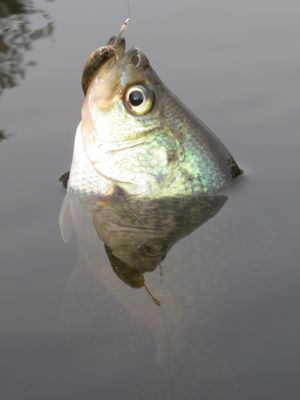
All along the Mid-Atlantic Coast, anglers are often kept inside for much of January and February due to bitter cold and snow. Fortunately, March can be milder and fish may feed on warmer days.
In much of the country, black crappie are among the first species that anglers target in the late Winter and Spring. In ponds, lakes and creeks, crappie move into the shallows on sunny days, feeding aggressively in the warm water.
To prepare for a late winter or early season crappie trip, anglers have a variety of things to consider. First is a trip to the local tackle shop, as many anglers will need new fishing licenses, fresh line, bait, and perhaps a few lures. Crappie tackle is affordable and simple to find. A few basic lures will usually suffice.
For starters, most anglers find that a small selection of jigs and soft plastic bodies to be productive. Jigs in the 1/16 to 1/4 oz. range usually work well, with curly tail bodies in chartreuse, white, and motor oil being popular colors.
Other soft plastic body styles may be used with size, shape and color open to experimentation. Traditional crappie jigs are also essential, with a few patterns being the most popular.
Small jigs are fished alone or sometimes with a spinner blade, depending on conditions and angler preference. For an entire season of crappie fishing, a more extensive selection of lures might be necessary, but in the cool waters of spring, simple jigs are often all that is needed.
Rather than use artificial lures, many anglers will fish for crappie with live bait. Common crappie baits include minnows, nightcrawlers, bloodworms, maggots, grass shrimp, and small crawfish.
Live baits can be fished under a bobber or on a 2 hook bottom rig. Another popular crappie rig uses a small jig head in combination with a live minnow.
Weather conditions are important for early season crappie fishing. Depending on factors, crappie may suspend in deeper areas or move into shallow flats to feed. In late winter thru early spring, anglers sometimes achieve excellent results if they are able to catch a sunny day with calm or moderate winds.
In these conditions, anglers can scout the body of water, looking for areas of flat, shallow water that are exposed to direct sun. Water temperature often rises considerably in these conditions, triggering fish to feed.
Casting jigs is a good way to locate early season crappie. A slow retrieve, combined with occasional twitches of the rod are known to be effective. Once crappie are located, anglers can continue to cast or switch to live baits. If the weather does not cooperate, other tactics may be necessary.
Late Winter and early Spring weather can be very unpredictable and subject to change at a moment’s notice. Sunny days are not a sure thing and in some areas, rain and even snow are constant problems.
Not only does rain and snow hamper immediate fishing, but excessive runoff can shut down fishing for days. Storm water may carry silt and debris which hamper visibility and rising water levels scatter crappie and baitfish. Anglers can do little but wait in these situations.
Once things settle down, crappie enthusiasts may find fish suspended near channel edges, waiting to move when conditions improved. If the fish remain in this holding pattern, their suppressed appetite may be triggered by being very patient and vertically jigging with crappie jigs, soft plastics, or small metal jigs.
As with other situations, a live minnow or other live bait may also incite fish to strike if fished at the correct depth.
As the weather cycles thru periods of warm clear days mixed with storms, anglers can switch tactics as necessary, watching for changes in behavior. Eventually warm weather will dominate the season and crappie will begin the spawning season.